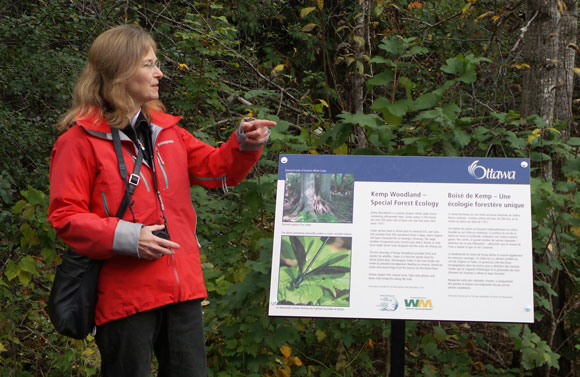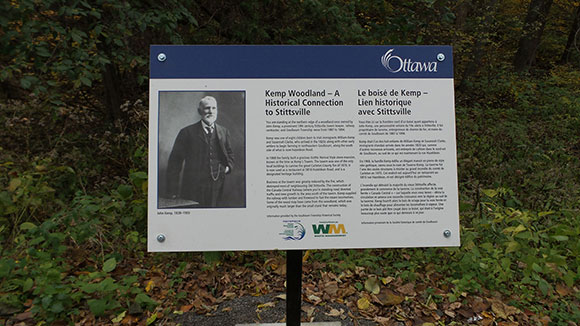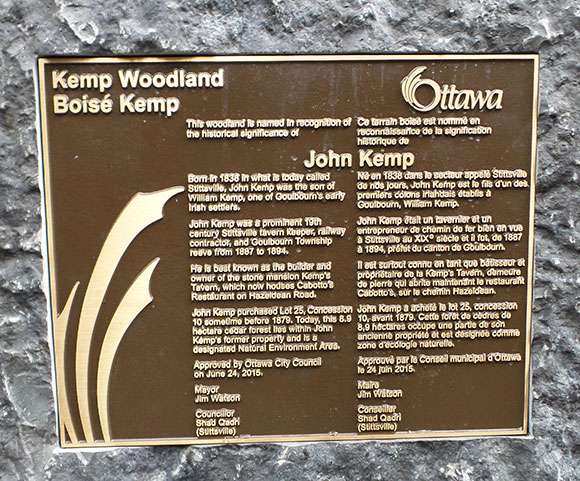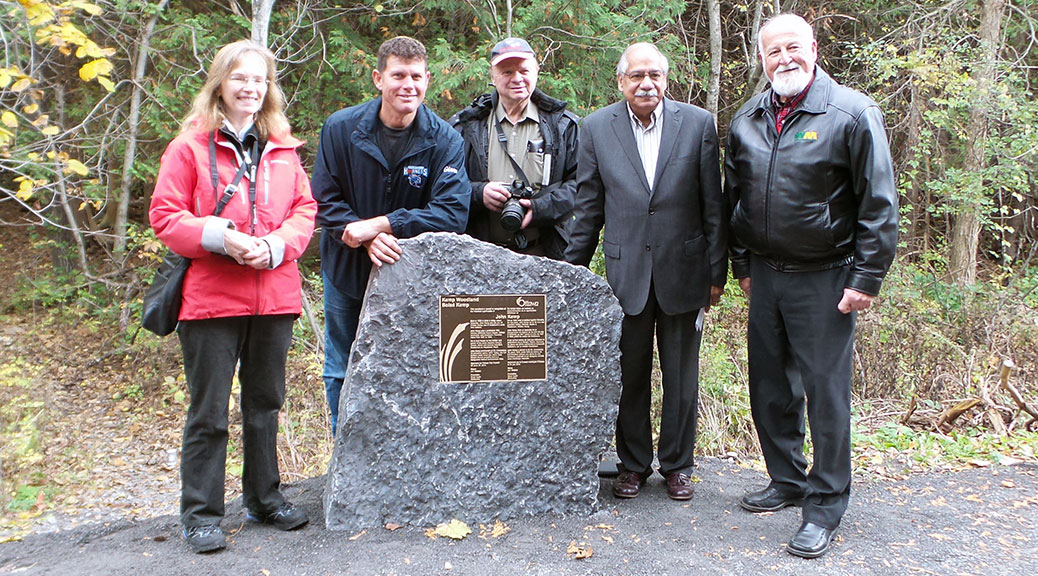(ABOVE: Unveiling of the Kemp Woodland plaque. Left to right: Janet Mason (Ottawa Stewardship Council), Glen Carr (Sacred Heart High School), Phil Sweetnam (Stittsville Village Association), Councillor Shad Qadri, Wayne French (Waste Management).
Ecological studies in the Kemp Woodland, including work carried out by Sacred Heart High School students, have discovered several cedar trees over 200 years old, including one that dates back to 1761.
Janet Mason, chair of the Ottawa Stewardship Council (OSC), and Glen Carr, an environmental science teacher at Sacred Heart High School, were on hand for a small ceremony on Friday afternoon to unveil new signage for the forest.
The Council has been working with Sacred Heart students to care for the 8.9-hectare forest adjacent to the school along the Trans Canada Trail.
The project started about two years ago and has become a model that Mason would like to see replicated with other schools in the city.
“There are 100 natural areas across the city to steward,” said Mason. “The City does not have the resources to do it alone.”

The goal of the project is to restore and provide sustainable care for the forest, including studying plants and wildlife and enhancing the existing trails. (You can read more about the project here…)
The program is funded through a $25,000 grant from Waste Management, money that comes from a community development fund that the company paid into as part of the operation of the Carp Road landfill.
Signage unveiled today included a large stone marker and plaque, an interpretive sign about the forest ecology, and a sign explaining the history behind the forest’s new name.

John Kemp was a 19th century Stittsville tavern keeper, railway contractor, and reeve of Goulbourn Township. His family built what’s now known as “Cabotto’s” on Hazeldean Road in 1868. He also supplied the railway with lumber and firewood to fuel the steam locomotives. Some of the wood may have come from this forest.
Mason had a long list of people and organizations to thank for getting the project off the ground, including:
- Sacred Heart High School
- Stittsville Village Association
- Waste Management
- Councillor Shad Qadri
- Various City of Ottawa experts and departments, including forestry, natural heritage system, and parks and recreation.
- The Rideau Valley Conservation Authority
- The Macnamara Field Naturalists Club
- Stittsville News editor John Curry and Glen Cairn resident Faith Blacquiere and the Goulbourn Township Historical Society for historical research.






I don’t think there are many if any that are actually over TWO CENTURIES OLD, there was that fire of 1870 that just about burned everything and finished just about at the doors of Parliament.
Here is a piece from THE GREAT FIRE OF 1870
AUGUST 20, 2014 / TODAY IN OTTAWAS HISTORY……..
The village of Stittsville, sixteen miles distant from Ottawa succumbed to the flames, then did Bells Corners, a mere nine miles from the capital. In Bells Corners, the only buildings left standing were “Mrs Bell’s house, two churches and a schoolhouse.” In Nepean and March, only three houses over a distance of 15 miles survived. Flames also consumed the newly-constructed buildings of the Ottawa Agricultural Society at Lansdowne Park, then outside the city limits.
Mr. Stuart – thanks for bringing this up! Not *everything* in Stittsville/Goulbourn was lost. For example, Kemp Tavern (now Cabotto’s) was built in 1868 and survived; there’s a small stone house on Maple Grove; there are a couple stone homes in old Hazeldean (now Glen Cairn) that pre-date the fire. I asked Janet Mason if she had any more context around the older trees, and here’s what she emailed me today:
“We discussed this with the Goulbourn Historical Society and field naturalists. It is possible for some trees to have survived the fire. First, that area used to be a swamp so it would have been quite wet. Second, even the largest conflagrations do leave some areas untouched; fire leaps and shifts. The trees would have been smaller then and might even have been singed, but the swamp would have had a cooling effect and given the trees ready access to water to recover quickly.
In 2015 the teacher at the high school, Glenn Carr, and his class took core samples of about 60 trees and then counted the rings so I am fairly certain that the ages are correct. Theirs girths are also consistent with the ages. The oldest trees were as follows:
1. age 253 years, circumference 230 cm.
2. age 219 years, circumference 199 cm.
3. age 196 years, circumference 178 cm
4. age 176 years, circumference 160 cm
5. age 174 years, circumference 158 cm”
The fact that those trees survived “The Great Fire” makes them even more remarkable!
https://todayinottawashistory.wordpress.com/2014/08/20/the-great-fire-of-1870/
https://kitchissippi.com/2014/12/15/ottawa-valley-great-fire/
Thanks for getting back to me Glenn, as a descendant from an family of botanist and arborist I am very interested in these surviving trees, I just hope the science used is accurate.